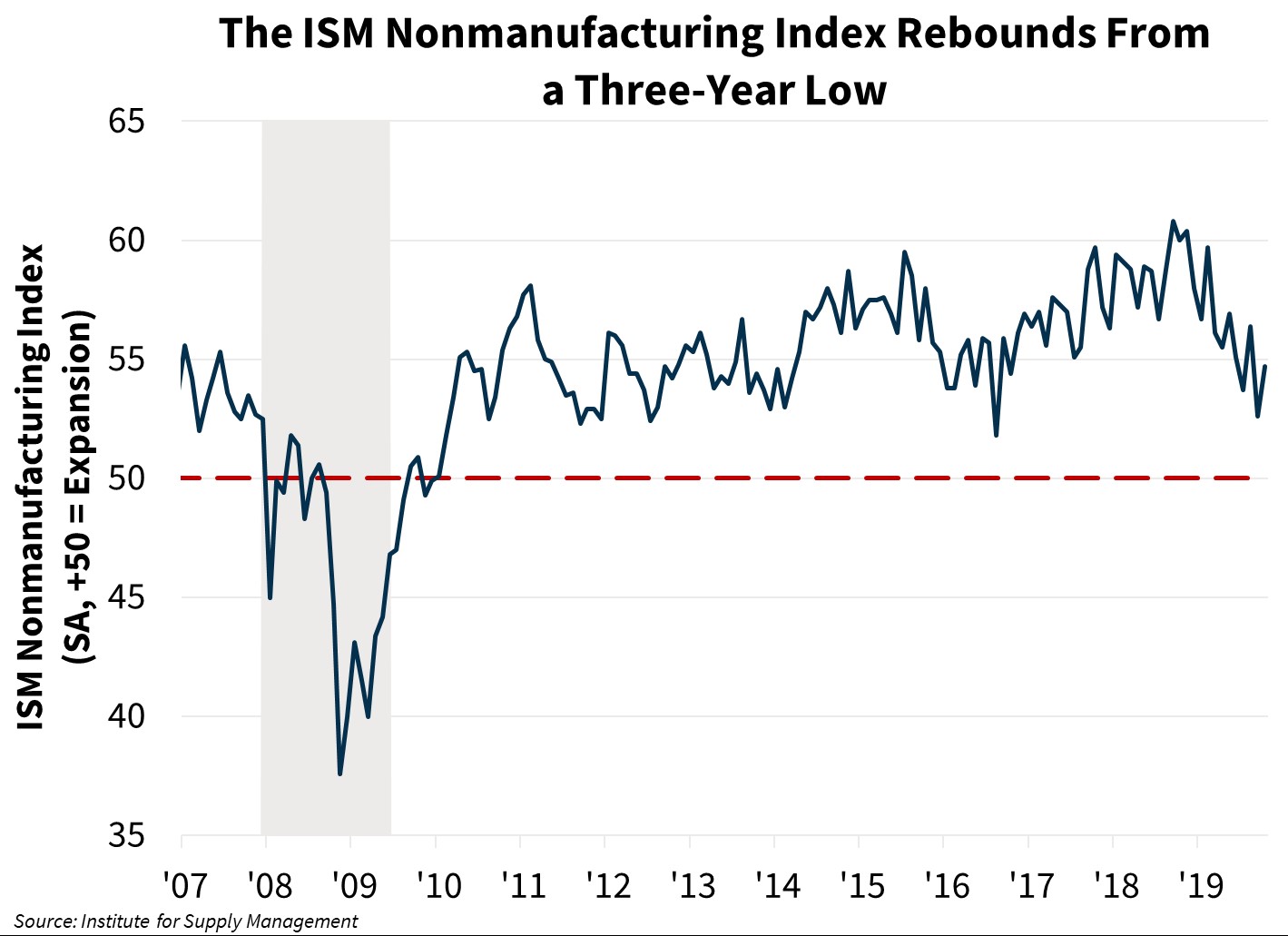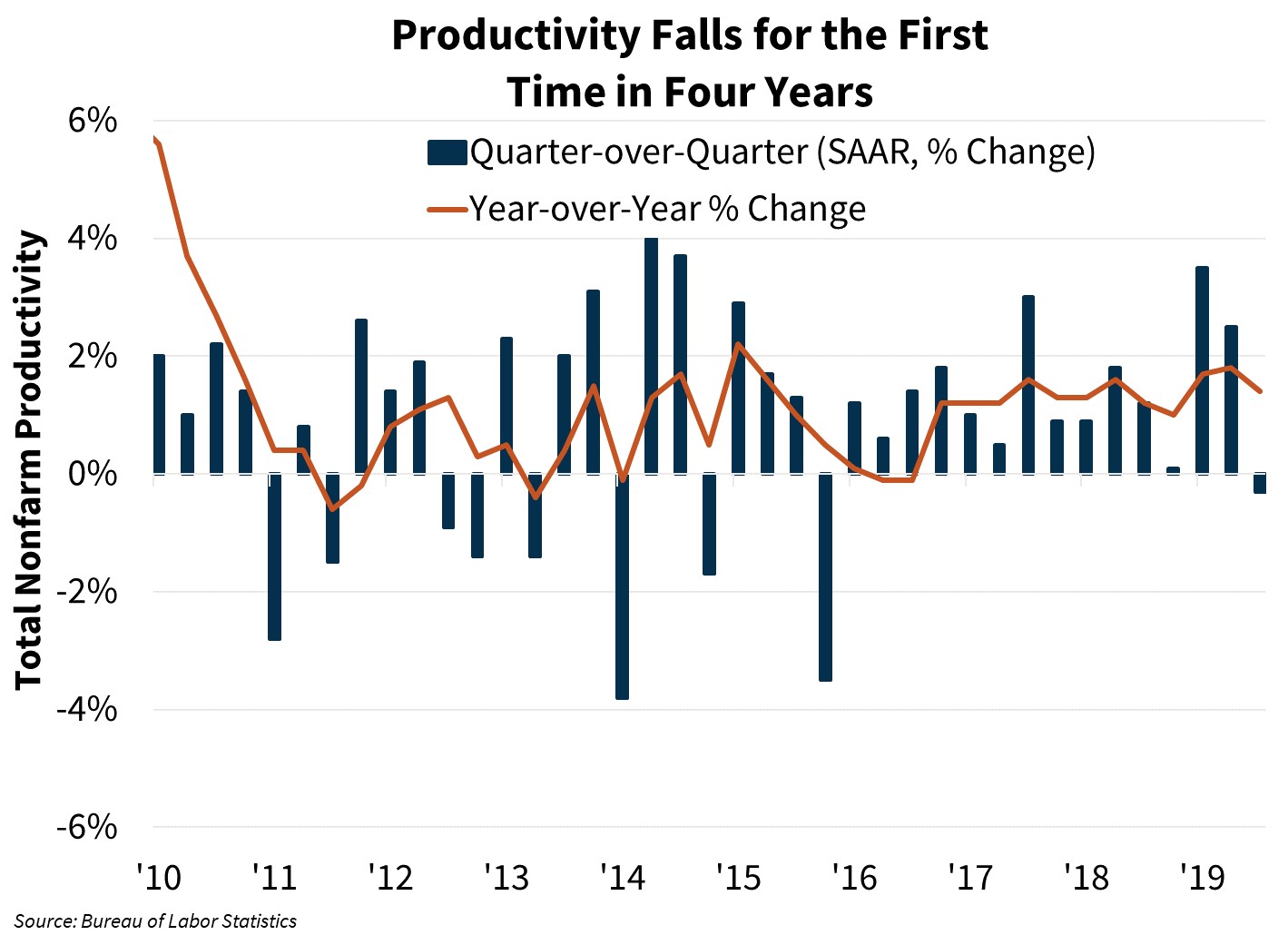The Service Sector Remains Healthy as Productivity Falls
Key Takeaways
- The ISM Nonmanufacturing Index rose in October, partially reversing the sharp drop seen in September. Both the business activity index and employment index increased, with the latter rising by the most since May. However, both the export and import indices fell, with the export index falling to the lowest level since January 2017 and the import index contracting for the second straight month, the first multiple contractions since the beginning of 2016.
- Nonfarm business productivity fell in the third quarter on an annualized basis for the first time since Q4 2015, driven by a sharp increase in total hours worked, which rebounded from the decrease in the second quarter and rose at the fastest pace since Q4 2017, while real output rose only slightly from last quarter. Unit labor costs also rose on an annualized basis in the third quarter, and on a year-over-year basis rose by the most since 2014.
- The Federal Reserve’s Senior Loan Officer Survey showed banks tightening credit standards for most residential mortgages in the three months ending in October, for the first time since Q2 2014. The net share of banks reporting increased demand for residential mortgages pulled back slightly in the fourth quarter from the third quarter’s seven-year high but remained elevated.
- The annual growth in the CoreLogic National House Price Index accelerated in September for the second consecutive month to 3.5 percent, the fastest pace in six months. This is the first two-month streak of annual acceleration since the beginning of 2018.
Forecast Impact
The increase in the nonmanufacturing index in October showed that the service sector continues to remain robust. Both the business and employment components increased, though the decrease in the import and export components underlines the continued risks from trade policy uncertainty, which we expect to drag on growth in the coming months. The decline in productivity over the third quarter and increase in unit labor costs are concerning for corporate profits, but we expect to see increased business investment in the fourth quarter, which should help spur productivity back to positive territory – though a sustained decrease in productivity would signal further weakness in growth. In terms of housing, the lower mortgage rate environment has led to a surge in the demand for residential mortgages, which we believe bodes well for home sales in the fourth quarter; however, the dearth of inventory will likely limit the number of sales, regardless of demand.


Details on Key Takeaways and Other Releases
- The ISM Nonmanufacturing Index, a gauge of service sector activity, rose 2.1 points in October to 54.7. (any reading above 50 indicates expansion). All major components of the index rose except for the prices index, which fell 3.4 points to 56.6. Among other components, the imports index fell 0.5 points to 48.5, while the exports component fell 2.0 points to 50.
- Nonfarm business productivity fell 0.3 percent annualized in Q3 2019, according to preliminary estimates by the Bureau of Labor Statistics. Real output rose 2.1 percent annualized, while total hours jumped 2.4 percent annualized. Unit labor costs rose 3.6 percent annualized and 3.1 percent from a year ago.
- The Federal Reserve Board Senior Loan Officer Opinion Survey in the three months ending in October showed that banks reported a small amount of tightening in lending standards for all residential mortgages except those that are GSE-eligible and jumbo loans to individuals. Banks continued to report strong demand for residential mortgages across all categories. Banks also reported tightening lending standards for commercial real estate, as well as a decrease in demand for commercial real estate loans.
- The CoreLogic National House Price Index, a repeat sales measure, rose 0.4 percent in September (not seasonally adjusted) and 3.5 percent from a year ago. On a quarterly basis, the index rose 3.4 percent year over year in the third quarter.
Ricky Goyette
Economic and Strategic Research Group
November 8, 2019
Opinions, analyses, estimates, forecasts and other views of Fannie Mae's Economic and Strategic Research (ESR) Group included in these materials should not be construed as indicating Fannie Mae's business prospects or expected results, are based on a number of assumptions, and are subject to change without notice. How this information affects Fannie Mae will depend on many factors. Although the ESR group bases its opinions, analyses, estimates, forecasts and other views on information it considers reliable, it does not guarantee that the information provided in these materials is accurate, current or suitable for any particular purpose. Changes in the assumptions or the information underlying these views could produce materially different results. The analyses, opinions, estimates, forecasts and other views published by the ESR group represent the views of that group as of the date indicated and do not necessarily represent the views of Fannie Mae or its management.
